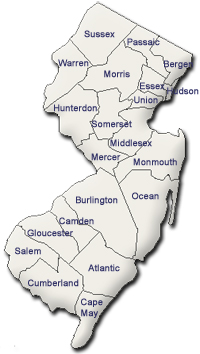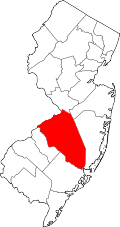Related Topics
The Proprietorship of West Jersey
The southern half of New Jersey was William Penn's first venture in real estate. It undoubtedly gave him bigger ideas.
Up the King's High Way
New Jersey has a narrow waistline, with New York harbor at one end, and Delaware Bay on the other. Traffic and history travelled the Kings Highway along this path between New York and Philadelphia.
New Jersey (State of)
 The Garden State really has two different states of mind. The motto is Liberty and Prosperity.
The Garden State really has two different states of mind. The motto is Liberty and Prosperity.
Burlington, Capital of the Province of West Jersey

|
| Burlington County Map |
Perth Amboy sits on a high bluff overlooking New York harbor bordering the north side of the Raritan River, while Burlington sits on a high bluff overlooking Delaware Bay from the south. Each of them was originally the capital of a province. The eighty-mile strip of land between them is the wasp waist of New Jersey (Nova Caesaria) containing enough land to satisfy the needs of the handful of early settlers. This strip, as the shortest land distance between Delaware and the Hudson, seemed destined to be the commercial main line along the Atlantic seaboard. Ultimately, Scottish Quakers were comfortable moving into hilly East Jersey stretching to the northward on what used to be mainland; while the English Quakers were comfortable with the flat sandy loam stretching to the south into the piney woods that once were an oceanic barrier island. George Fox, the founder of Quakerism, had visited the area in 1671 and pronounced favorably on the fair prospect around Bridlington, now Burlington; the founding meeting of the two Quaker proprietorships was held there. Because of dissension within East Jersey, Queen Anne combined the two provinces into a single royal colony in 1701, with its colonial capital in Perth Amboy. The state capital moved to Trenton in 1790, following which the whole region prospered in response to the nation's first commercial railroad, the Camden and Perth Amboy RR. Ultimately, the flaw in this project was that the early railroad easily crossed the narrow Raritan but came to a dead halt in Camden, where it could not hope to cross the mile-wide Delaware at Philadelphia. When the Pennsylvania Railroad crossed Delaware at Trenton, the century-long prosperity of New Jersey from Trenton to Camden was doomed to slow decay.
One enduring symbol of the commercial decline of Burlington is in the second largest restaurant in town, located within an imposing bank building, whose remaining bank vault door towers over the dining area, and is only the first-floor vault. Another one like it is on the second floor. This bank turned restaurant is at the corner of two broad intersecting business avenues, one traveling north-south with a railroad track down the center, and the other leading to the fine esplanade on the bluff above the dock area. Sheltering the old docking area is Burlington Island, large enough to contain a hundred-acre lake.
Just south of the main street to the river is a handsome and well preserved colonial street, just waiting to become the center of a second Williamsburg revival, but curiously containing a house used by General Ulysses S. Grant, and -- not so curiously -- the family seat of the Haines family who have loomed large over West Jersey for many -- perhaps thirteen or fourteen -- generations.
If you go back to the other main street, the one with the railroad tracks, there is a little open-air station used by riders of the light rail Riverline which has flourished beyond all expectation as a less expensive way to commute to New York. In six months of operation, the Riverline has exceeded the ridership prediction for ten years ahead, so it's easy to predict more trains will be purchased to accommodate increased traffic, and home construction for commuters is probably not long in the future as well.
Just across the road from this little station stands a tiny one-story building, next to several imposing Federalist style red brick homes. You have to look up at the medallion over the door to identify this building as the present home of the Proprietors of West Jersey. This particular building was built in 1919, replacing an older one which used to be across the street. Inside the Proprietor building, behind the walls of small bank vaults, were the invaluable historical documents and maps of the Proprietorship, dating back to the signatures of William Penn and other notables taught about in the schools of the region. There was the Quintipartite Deed, signed by three Quakers (Penn, Gawen Lorie, Nicholas Lucas) and both George Carteret and Edward Billinge, establishing the boundaries of East and West Jersey; and there was the document of Concessions and Agreements, one of the major precursors of the United States Constitution; the Tripartite Indenture, and various early agreements of land sales. After a frustrating effort at break-in, these documents were copied and the originals sent to the State Archives. It seems a great pity to lose the testimony to the public trust that came along with having three-hundred-year-old relics easily and simply available for public view, just by walking up and asking to see them. But these are signs of the times; the greatest warning came from the rifling of the Christopher Columbus museum in Boalsburg, Pennsylvania, where any passerby could honk his horn and ask to see the sea chest and crucifix that Columbus actually used on his voyages to the brave new world, that hath such creatures in it.
REFERENCES
| New Jersey, A Historical Account of Place names in the United States: Richard P. McCormick: ISBN-13: 978-0813506623 | Amazon |
Originally published: Friday, January 02, 2009; most-recently modified: Wednesday, May 15, 2019